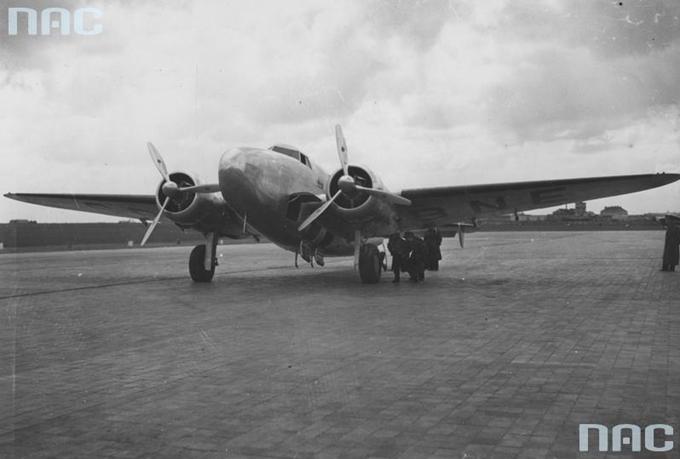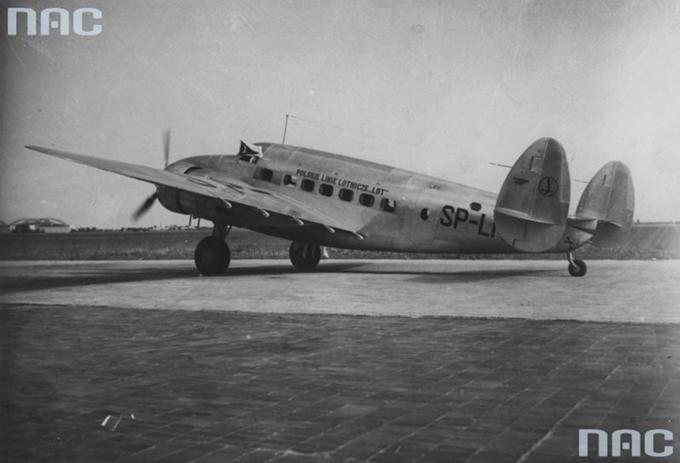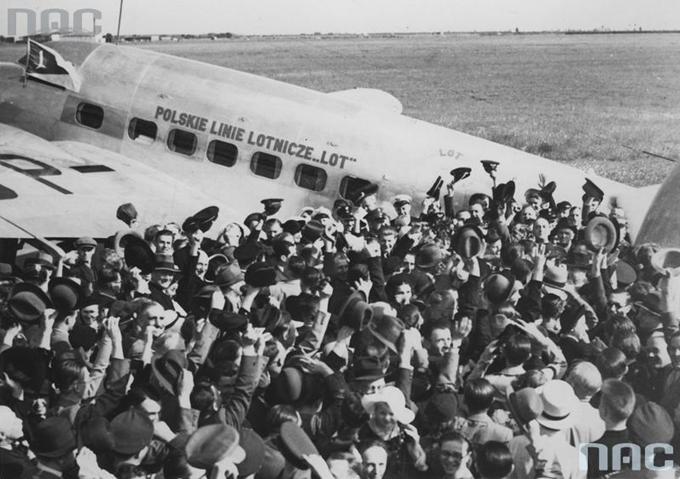Kraków 2013-05-10
History
00136a Tally 1.02.1936.
Lockheed L-10 Electra, L-14 Super Electra in Poland.

History of construction.
The Vega aircraft allowed Lockheed to gather valuable experience in the construction of high-speed aircraft with the only then effective piston-propeller drive. In the mid-1930s, it was already certain that passenger planes with a cruising speed of well over 200 km / h would be created. This will significantly shorten the time of transporting mail and passengers. In the US, three companies have joined; Boeing Type 247, Douglas DC-2 and Lockheed L-10. Hall Hibbard headed the design team at Lockheed Aircraft Corporation in 1933. At that time, large passenger planes took 6 to 12 people on board. In order to optimize the project, it was first necessary to determine the number of people transported, as their number determined the size of the fuselage and the entire aircraft. The cabin crew (flight attendants) were also not taken into account, as the constructors assumed that the fast flight would be temporarily short. In addition, it was found that passengers do not have to assume an upright position in the cabin, so the fuselage may be limited to accommodating passengers on the seats. The small dimensions of the airframe mean a gain in weight. As a result, a weaker (read lighter) and more economical powertrain can be fitted. This will translate into a considerable range. As a result, a passenger plane was developed, which should rather be called a large air taxi or air bus. But the goal was achieved - fast travel. In the fuselage there was room for two pilots (already then the US regulations required two-person crews in commercial aviation) and 10 passengers sitting in individual seats (5 seats on each side) with a passage in the middle. Armchairs are a bit of an exaggerated name, and a better term is a deep, soft chair that provided relative comfort. There was no kitchen in the cabin, and therefore no meals served by the lines. There was also no toilet. It is impossible to dream of a standard that was offered in Curtiss Condor airplanes. For a passenger plane, the Lockheed L-10 Electra has a very short fuselage, which is no more than 12 m (11.80 m) long.
Various models were used extensively in the design work for wind tunnel testing. During these tests, the vertical tail was redesigned from single to double, which later became the hallmark of Lockheed aircraft.
The aircraft was designated Lockheed L-10 Electra. The first flight took place on February 23, 1934. During the tests, the plane reached a speed of 325 km / h. After trials and taking into account the corrections, in 1935, serial production was launched, which lasted until 1943. A total of 149 were built, which was a very good result. It should be remembered that in 1934, the US administration, through the department of aviation, issued a ban on the carriage of passengers on commercial flights by single-engine airplanes. This decision resulted in increased demand for twin-engine planes and increased production of the L-10 Electra. Lockheed L-10 Electra planes went to; USA, Argentina, Brazil, Honduras, Spain, Canada, UK and Poland. Airplanes were used for commercial purposes (passenger and mail transport), but also in the armed forces.
The Lockheed L-10 Electra plane in the first L-10 A variant was equipped with two Pratt & Whitney R-985 Wasp Junior SB engines with a power of 2 x 340 kW (450 HP). 101 examples were built of this variant. Other varieties; Electra L-10-B (18 units), engine: 2 x Wright R-975-E3 Whirlwind, 340 kW (440 hp). Electra L-10-C (8 units), engine: 2 x Pratt & Whitney R-1340 Wasp SC1, 336 kW (450 HP). Electra L-10-E (15 units), engine: 2 x Pratt & Whitney R-1340 Wasp S3H1, 450 kW (600 HP) (version of Amelia Earhart's aircraft).
The greatest publicity was brought by the Lockheed L-10 Electra design's failed attempt to fly around the world along the equator. The feat was undertaken by the world-famous pilot Amelia Earhart, who, after covering half of the route, died over the Pacific Ocean.
Lockheed L-10 Electra planes took part in World War II. Single copies were used until the 70-years of the twentieth century.
Lockheed L-10 Electra in PLL LOT.
Lockheed L-10 Electra planes were also used by LOT Polish Airlines. At the beginning of 1936, the dynamically developing LOT company did not differ in terms of the level of services and the network of connections from other leading carriers. The LOT Management Board decided to use 10 Lockheed L-10 Electra machines. At the beginning of 1936, a ship with four planes arrived at the port of Gdynia. They were assembled at Rumia Airport and flown. They were transported by air to Warsaw to the Okęcie Airport. Received registrations; SP-AYA, SP-AYB, SP-AYC, SP-AYD. From March 1936, regular cruises began. In 1937, PLL LOT received the remaining 6 machines, registrations; SP-BGE, SP-BGF, SP-BGG, SP-BGH, SP-BGI, SP-BGJ.
Unfortunately, Lockheed L-10 Electra planes did not fly long, because in 1939, the German army deprived the Republic of Poland of independence, initiating World War II, together with the CCCP.

Lockheed L-14 Super Electra.
The success of the L-10 aircraft attracted shipping companies to a larger design. The team of designers was headed by Don Palmer. The plane was enlarged to accommodate 14 passengers. The prototype was built at the Lockheed plant in Burbank. The first flight was made on July 29, 1937. In the period 1937 - 1940, 354 examples were built. Two Wright SGR-1820-F62 engines with a power of 2 x 567 kW were used as the drive. Customers could also choose a drive with two Pratt & Whitney R-1690 Hornet engines. The aircraft was manufactured under license from Tachikawa plants in Japan.
It should be emphasized that the performance of the L-14 in relation to the L-10 has increased dramatically. Speed increased by 23% and range by nearly 200%.
Lockheed L-14 Super Electra in PLL LOT.
In 1937, it was decided to purchase 10 machines of the new, enlarged version, i.e. the L-14. The first five machines arrived in Poland on board the ocean liners MS Batory and MS Piłsudski in April and May 1938. The machines were assembled at Rumia Airport, as was the case with the L-10 Electra. Another four planes arrived in Poland in June 1938.


The authorities of PLL LOT decided to use the purchase of a modern aircraft for propaganda purposes. It was decided that the last machine would be brought from the factory in Burbank to Warsaw by air. It was supposed to be a test in the possible launch of an airline connecting Warsaw with New York and Chicago. Interestingly, the Atlantic Ocean was to be crossed at its narrowest point, i.e. from Natal in Brazil to Dakar in Senegal. The flight took place in May 1938. The crew consisting of: Wacław Makowski (LOT director and first pilot), Zbigniew Wysiekierski (co-pilot), Szymon Piskorz (mechanic), Alfons Rzeczewski (radio navigator) and Jerzy Krassowski (assistant) took off in a brand new plane from Burbank, California on 13.05 .1938. Via Mazatlan, Mexico, Guatemala, Lima, Buenos Aires and Rio de Janeiro, the machine reached Natal, Brazil. From there, in 11 hours and 10 minutes, the crew crossed the Atlantic Ocean and landed in Dakar, covering a record distance of 3,070 kilometers without stopping. Then the route led through Senegal, Casablanca, Tunis and Rome, from where the plane arrived on June 5, 1938, directly to the Okęcie airport in Warsaw. In total, during the flight from California to Poland, the machine spent 85 hours in the air. The flight over the record distance of 24,850 km had an advertising and propaganda significance, but also was to be a preparation for the commencement of regular transatlantic flights in 1940. These plans were thwarted by the German army, initiating World War II.

Soon, LOT Polish Airlines lost two machines: the SP-BNG crashed in July 1938, near Campulung in Romania, and the SP-BNJ burned down at the airport in Bucharest shortly after. To make up for the losses, in May 1939, another four L-14 Super Electra were brought to Poland. During the defensive war of 1939, all Lockheed Electra planes were mobilized by the Polish Army and performed courier and supply flights. Then four of them were evacuated to Romania, where they were interned. One machine was interned in Tallinn, Estonia. The remaining three planes of this type (SP-BPM, SP-LMK and SP-BNF) were evacuated to France, where they served as liaison planes for Polish diplomacy. The SP-BPM was destroyed during the German attack on France in June 1940, and the SP-LMK and SP-BNF flew to Great Britain. There, they were planned to be converted into planes for "cichociemni" airdrops, but eventually the idea was abandoned and both machines took over the BOAC lines.
Written by Karol Placha Hetman
